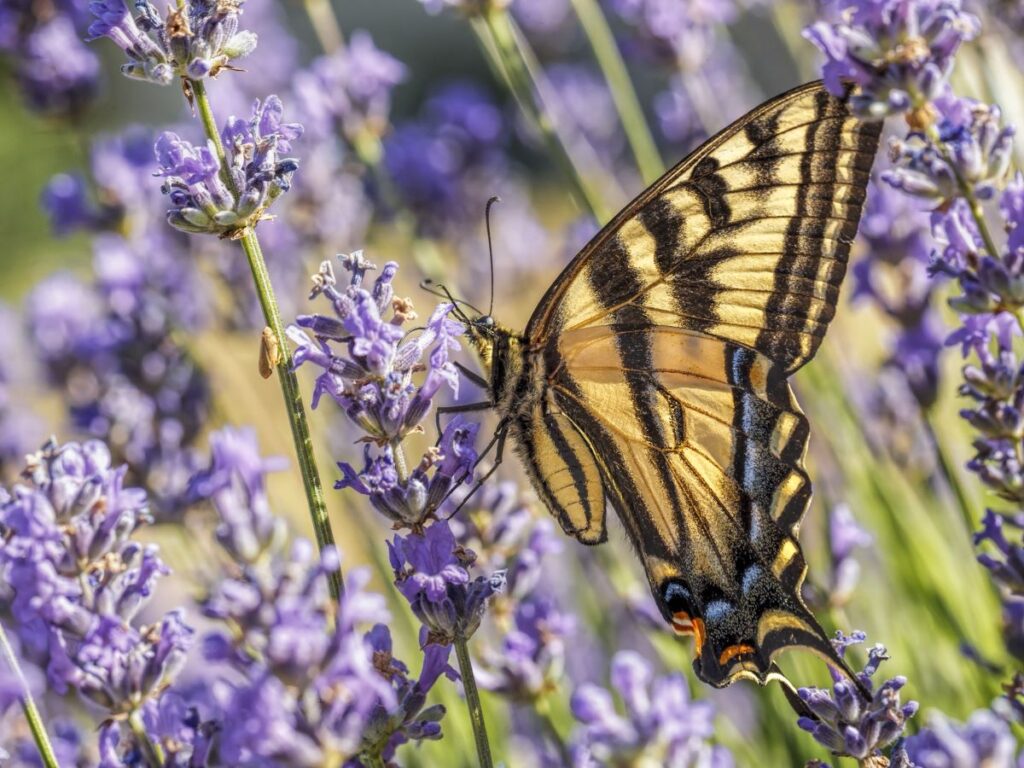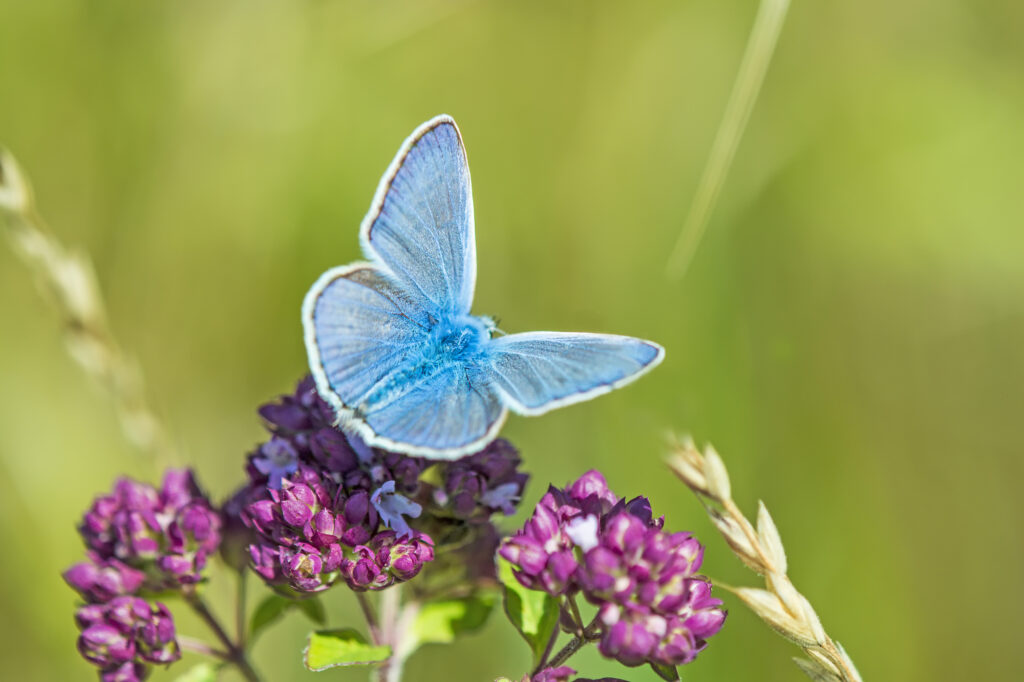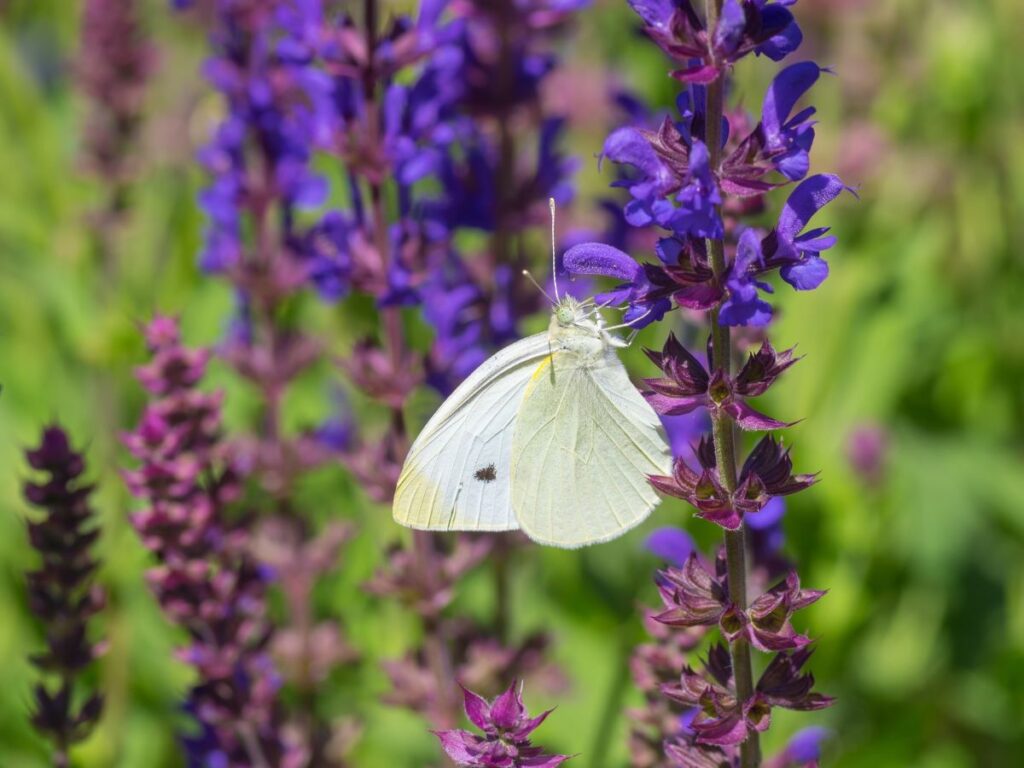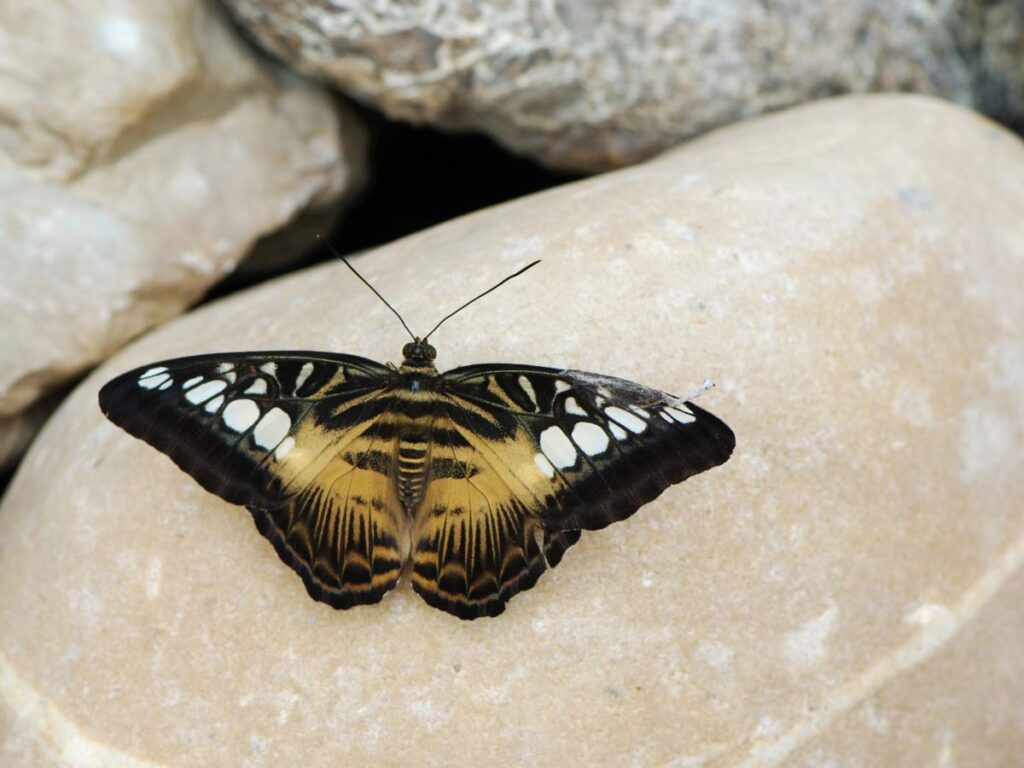Watching butterflies flit through your garden is a delight for any home gardener. If you want to create a butterfly oasis, choosing the right herbs is a great place to start. Certain herbs are like magnets to these delicate creatures. And understanding which herbs attract butterflies can ensure your garden is buzzing with activity.

The fragrant blossoms and essential oils of many herbs are irresistible to butterflies. Your gardens serve an important role in the life cycle of butterflies, providing nectar and a place for them to lay their eggs. By selecting a variety of these plants, you create a hospitable environment for different butterfly species.
The 6 Basics of a Successful Herb Garden
A successful butterfly garden has six important parts that make it a cozy home for butterflies. Let’s break it down:
- Colorful flowers that provide nectar for adult butterflies.
- A food source for the larvae (the caterpillars).
- Protection from wind and rain.
- Sunshine and warming surfaces to warm their bodies for flight.
- A source of moisture, minerals and other nutrients.
- A successful herbal butterfly garden is also pesticide-free.
In this guide to creating a flower garden of herbs that attract butterflies, I’m going to walk you through each of these requirements. You’ll discover that it is amazingly easy to bring butterflies into your yard so let’s get started.

Step 1: Plant Herbs that Attract Butterflies
You can use this chart as a quick reference for the flowering characteristics and growing preferences of various herbs that attract butterflies, moths and other beneficial insects. Adding one or more of these nectar plants to your flower beds will help bring butterflies to your yard.
Below the list, we’ll go into more detail about each herbs that are perfect choices to add to your garden.
| Herb | Flower Color | Peak Flowering Time | Sun or Shade Preference | Annual/Perennial |
|---|---|---|---|---|
| Sage | Blue, Purple, White | Late Spring – Summer | Full Sun | Perennial |
| Mint | White, Pink, Purple | Summer | Full Sun to Part Shade | Perennial |
| Basil | White, Purple | Summer | Full Sun | Annual |
| Dill | Yellow | Late Spring – Summer | Full Sun | Annual/Biennial |
| Parsley | Yellow-Green | Summer | Full Sun to Part Shade | Biennial |
| Yarrow | White, Yellow, Pink, Red | Early Summer – Fall | Full Sun to Part Shade | Perennial |
| Fennel | Yellow | Summer | Full Sun | Perennial |
| Chives | Purple-Pink | Spring – Early Summer | Full Sun to Part Shade | Perennial |
| Catnip | White with Purple Spots | Summer – Fall | Full Sun to Part Shade | Perennial |
| Lavender | Purple | Late Spring – Early Summer | Full Sun | Perennial |
| Bee Balm | Red, Pink, Purple, White | Summer | Full Sun to Part Shade | Perennial |
| Thyme | Pink, Purple, White | Summer | Full Sun | Perennial |
| Oregano | Pink, Purple | Summer | Full Sun to Part Shade | Perennial |
| Hyssop | Blue, Pink, White | Summer | Full Sun | Perennial |
| Lemon Balm | White | Summer | Full Sun to Part Shade | Perennial |
And a little further down we’ll share some tips to help you design a Butterfly Herb Garden.
Herbal Favorites of Butterflies
Butterflies are drawn to gardens with a variety of herbs due to their vibrant flowers and enticing fragrances. Butterflies are attracted to flowers that are red, yellow, orange, pink and purple. Since they need to land to feed, you want herbs with blossoms that are flat-topped or clustered and have short flower tubes. Here are some of my favorite herbs that attract butterflies.
Sage (Salvia officinalis)
Sage plants are characterized by their woody stems, grayish leaves, and spikes of flowers that can range in color from blue, purple, pink, or white. These perennial herbs are particularly attractive to butterflies and moths due to their brightly colored and nectar-rich flowers. The tubular shape of sage flowers is a wonderful choice for the long proboscises of many butterflies. Check out our Guide to Growing Sage.
Mint (Mentha spp.)
Mint is a vigorous, spreading plant known for its aromatic leaves and spiky flower clusters that can be white, pink, or purple. The strong scent of mint leaves attracts a variety of butterflies and moths. The dense foliage of any member of the mint family provides shelter for these fragile insects. And mint’s abundant flowers provide a continuous source of nectar throughout the summer.
Basil (Ocimum basilicum)
Basil is a popular culinary herb with lush, green leaves and spikes of small white or purple flowers. Its a great addition to your garden due to the long blooming period which provides a reliable food source for most of the summer. The flowers are rich in nectar, which makes them highly attractive to butterflies and moths. Basil’s strong aroma can also help lure these insects to the garden. Check out our Guide to Growing Basil.
Dill (Anethum graveolens)
Dill is an annual herb with delicate, feathery leaves and umbels of tiny yellow flowers. These flowers produce both nectar and pollen that attract butterflies and moths. Additionally, dill is a host plant for caterpillars of the black swallowtail, providing a place for them to feed and develop. Check out our Guide to Growing Dill.
Parsley (Petroselinum crispum)
Parsley is a biennial herb with bright green, curly or flat leaves. It has small yellow-green flowers that form in umbrella-like clusters where it is easy for butterflies to land. While not showy, parsley’s flowers do produce nectar which butterflies and moths will feed. Parsley is also a host plant for the larvae of some butterfly species, making it doubly beneficial for attracting these insects.
Yarrow (Achillea millefolium)
Yarrow is a hardy perennial known for its feathery foliage. Its flowers are flat-topped clusters of small, tightly-packed florets that can be white, yellow, pink, or red. These flowers are particularly appealing to butterflies and moths because they offer an accessible, flat landing surface and a large quantity of nectar. The plant’s long blooming season provides a consistent food source for various pollinators.
Fennel (Foeniculum vulgare)
Fennel is a perennial herb with feathery, licorice-scented leaves and umbels of bright yellow flowers. The nectar-rich flowers are magnets for butterflies and moths. This herb also serves as a larval host, particularly for swallowtail butterflies.

Chives (Allium schoenoprasum)
Chives are a perennial herb with long, slender, tube-shaped leaves. The flowers are round, purple-pink flower heads that bloom in the spring. These flowers are not only visually attractive but also provide nectar for butterflies and moths. The onion-like scent of chives can help deter some pests, making it a beneficial companion plant in a butterfly garden.
Catnip (Nepeta cataria)
Catnip is a perennial herb well known for its effects on cats. It also features heart-shaped, toothed leaves and spikes of small white flowers with purple spots. The aromatic leaves and nectar-rich flowers are attractive to a variety of butterflies and moths. Catnip is easy to grow and can thrive in less fertile soils, making it a low-maintenance option for attracting pollinators. Check out our Guide to Growing Catnip.
Lavender (Lavandula spp.)
Lavender is a perennial herb prized for its fragrant, narrow leaves and tall spikes of purple flowers. The rich nectar and the strong, sweet fragrance of lavender’s showy flowers are irresistible to a wide variety of butterflies and moths. Growing lavender for its long flowering season provides a continuous feast for visiting pollinators.
Bee Balm (Monarda spp.)
Bee balm, also known as wild bergamot, is a tall perennial herb with a distinctive spiky flower head that can be red, pink, purple, or white. Its flowers are rich in nectar and its fragrance is highly attractive to a wide variety of pollinators, including butterflies and moths.
Thyme (Thymus vulgaris)
Thyme is a low-growing perennial herb with small, fragrant leaves. It has clusters of tiny, tubular flowers that can be pink, purple, or white. Its flowers are a good nectar source for butterflies and moths. Plus the plant’s dense growth habit provides shelter for fragile wings. Check out our Guide to Growing Thyme.

Oregano (Origanum vulgare)
Oregano is a perennial herb known for its aromatic leaves. It displays sprays of tiny, tubular flowers that are typically pink or purple. The nectar and pollen-rich blooms are attractive to an array of pollinators, including butterflies and moths. Check out our Guide to Growing Oregano.
Hyssop (Hyssopus officinalis)
Hyssop is an aromatic, perennial herb with narrow leaves and spikes of small, vibrant blue, pink, or white flowers. It is favored by pollinators for its nectar and is often planted in butterfly gardens to attract various species of butterflies and moths.
Lemon Balm (Melissa officinalis)
Lemon balm is a perennial herb with a lemony scent, toothed leaves. The abundant small white flowers of lemon balm are full of nectar. This plant is known to attract pollinators, including butterflies and moths, and can be a pleasant aromatic addition to a garden.

Step 2: Provide a Food Source for Butterfly Larvae
Once you attract butterflies to your garden, they are going to need a place to lay their eggs. The female butterfly is looking for a host plant that provides an abundance of food for the young caterpillars.
Here’s a list of herbs that are larvae hosts for a variety of butterflies:
- Thyme
- Sorrel
- Fennel
- Lemon Balm
- Parsley
- Dill
However, to attract the widest variety of butterflies you’ll need a few other plants to fulfill the role of larvae host. While the larvae of Black Swallowtail butterflies love to eat the parsley in your herb garden, Monarch butterfly caterpillars only feed on milkweed. And Tiger Swallowtail larvae prefer to feed on trees like willow and poplar.

Step 3: Choose a Location that Provides Protection
Since butterfly wings are rather fragile, they prefer a location where wind and rain won’t beat on them. Keeping in mind that they also like a sunny spot here are a few suggestions to provide your new butterflies protection from the elements:
- Use taller bushes in your herb garden design to help break the wind.
- Include herbs and flowers that are leafy to create places for them to hide.
- Avoid extremely open locations where the wind will be stronger. Utilize buildings or trees to create windbreaks.
Step 4: Offer Plenty of Sunshine and Warming Places
Butterflies need warmth to fly. A great way to get more activity is to place your herbal butterfly garden in a sunny location.
You’ll find they are also attracted to rocks where they can sun themselves. Rocks naturally hold in the heat from the sun. Incorporating large rocks into your butterfly garden will also add an attractive texture to your design.

Step 5: Incorporate a Water Source
Butterflies need water as much as they need nectar, but they can’t land on open water. So that means your garden pond or bird bath isn’t sufficient for them. A few ideas shared by the Wildlife Federation are:
A Puddling Area or Dish is an easy solution. It’s just a shallow place of wet mud. As you water your garden, you’ll naturally re-wet this space.
Shallow Rock Saucers are also simple to maintain. Use a saucer or pie pan, and then add rocks of 1 to 2 inches in diameter. Then keep water in the saucer for the butterflies to access.
Set out Ripe Fruit in a Dish. Butterflies will draw moisture from the fruit and also take in essential nutrients. Make sure you clean up the rotting fruit regularly to avoid a mosquito and fly infestation.
Butterflies will also take nutrients and minerals from the dirt, rocks and fruit that they need to reproduce.
Step 6: Keep Your Butterfly Garden Herbicide Free
Obviously, if a chemical is intended to kill bad insects, it will also destroy the good ones. So it is critical that when attracting butterflies to your herb garden to go organic. Use all-natural methods to keep your garden healthy.

Types of Butterflies You Might Attract
When you start planting herbs in your garden, you’ll likely notice an increase in butterfly visitors. Here are some of the types of plants that may come flitting your way:
- Monarch butterflies: Easily spotted by their vibrant orange and black wings, they enjoy milkweed above all.
- Swallowtails: These large butterflies showcase impressive tail-like extensions, with species like the Black Swallowtail attracted to parsley and dill.
- Painted Ladies: They’re fond of thistle, mallow, and hollyhock, recognizable by their orange, black, and white patterns.
- Red Admirals: Look for their striking red bands against a dark wing; they prefer nettles.
Remember, different butterflies may be attracted to different herbs based on their lifecycle needs:
Provide a mix of these plants, and you’ll set a welcoming table for a variety of winged guests. Keep an eye out for the subtle differences in their appearances and behaviors as they visit your herb garden.
Two Problems with Herbs in Your Butterfly Garden
You might already know that when you use herbs for cooking, their flavor is stronger and sweeter if you clip your herbs before they flower. Most gardeners of culinary herb gardens clip off flower buds before they ever flower.
And those hungry caterpillars are going to eat a lot of your leaves. I’ve seen dill and parsley decimated by butterfly larvae.
But you know what, it’s OK. Plant enough for everyone. Plant some for you, some for those gorgeous creatures. Let some of your herbs go to flower, and mark a few for your kitchen.
Garden Design Tips for Butterfly Gardens
To attract butterflies, your garden must provide what they need at all life stages. The following sections will guide you on how to create an inviting habitat for them.
Use a Range of Flowering Bloom Time
By ensuring that you plant herbs that bloom sequentially across the whole summer and into early fall, butterflies will continue to come to your garden. We included the average bloom time for nectar-rich herbs in the chart above to help you plan.
Choosing the Right Location
Your flower garden should be placed in an area that gets full to partial sunlight for at least six hours a day since butterflies are sun-loving creatures. Also, make sure your herbal butterfly garden is sheltered from strong winds. By utilizing fences, evergreen trees and taller bushes you can reduce the wind.
Pest Management: Organic and Non-Toxic
Chemical pesticides can harm butterflies. Choose organic solutions, such as introducing natural butterfly-friendly predators like ladybugs. For milder issues, a diluted soap spray can be effective without negative impacts on butterflies.
Garden Layout
Plan your garden so that taller plants are in the back and shorter plants are in the front, ensuring butterflies can access all plants easily. Include a mix of host plants for caterpillars and nectar-rich flowers for adult butterflies to feed on.
Color Considerations
Butterflies are attracted to bright colors. Incorporate a variety of hues, with a preference for red, yellow, orange, pink, and purple flowers. Planting in groups helps to create a visually attractive target for butterflies.
Companion Planting
The best gardens with herbs that attract butterflies also include a mix of other annuals and perennials to ensure you have adequate food sources. For example, milkweed plants are essential for monarch caterpillars. And flowers like asters and marigolds will extend the bloom time of your garden.
When you’re planning your butterfly haven, it’s smart to think beyond just herbs. Adding a variety of plants will create a rich environment that’s super inviting for those fluttery friends. Try these:
| Butterfly Plants | Flower Color | Peak Flower Time | Annual or Perennial |
|---|---|---|---|
| Zinnia | Various colors | Summer to fall | Annual Plant |
| Marigold | Yellow, orange | Summer to fall | Annual Plant |
| Cosmos | Pink, white | Summer to fall | Annual Plant |
| Lantana | Red, orange, pink | Summer to fall | Annual Plant |
| Sunflower | Yellow | Summer to fall | Annual Plant |
| Sweet Alyssum | White, pink, purple | Spring to fall | Annual Plant |
| Mexican Sunflower | Orange | Summer to fall | Annual Plant |
| Verbena | Various colors | Summer to fall | Annual Plant |
| Nasturtium | Yellow, orange, red | Summer to fall | Annual Plant |
| Salvia | Blue, purple, red | Summer to fall | Annual Plant |
| Butterfly Bush | Purple, pink, white | Summer to fall | Perennial Plant |
| Coneflower | Purple, pink, white | Summer to fall | Perennial Plant |
| Black-eyed Susan | Yellow, orange | Summer to fall | Perennial Plant |
| Aster | Purple, pink, white | Summer to fall | Perennial Plant |
| Butterfly Weed | Orange | Summer to fall | Perennial Plant |
| Milkweed | Pink, orange | Summer to fall | Perennial Plant |
| Joe Pye Weed | Pink, purple | Summer to fall | Perennial Plant |
| Phlox | Various colors | Summer to fall | Perennial Plant |
To have a year-round impact, include plants that bloom across the growing season. This ensures a constant source of nectar and other resources for your winged visitors.
A Few More Thoughts about Herbs that Attract Butterflies
Creating a butterfly garden is also a significant contribution to supporting local ecosystems and biodiversity. By choosing the right herbs such as lavender, fennel, milkweed, and oregano, you can provide a haven for these beautiful creatures.
Enjoy the dual benefits of vibrant flora and the fluttering presence of butterflies. Each herb offers unique nectar or foliage that caters to different stages of a butterfly’s life cycle, from caterpillar to mature butterfly.
Remember to consider the specific preferences of butterflies native to your region. And make sure you avoid the use of pesticides, which can harm these delicate insects.
Plant herbs that attract butterflies and soon your garden will become a bustling hub of butterfly activity.
